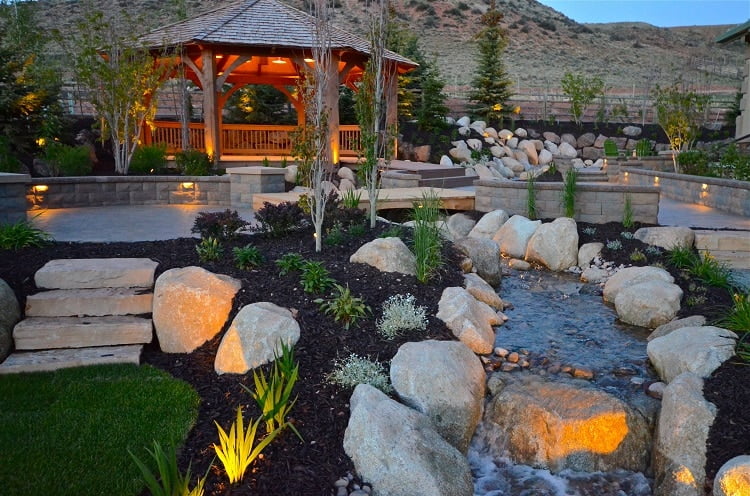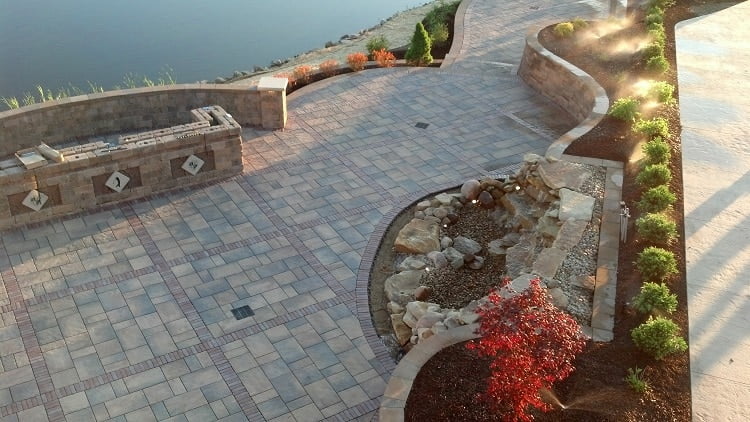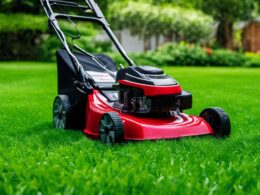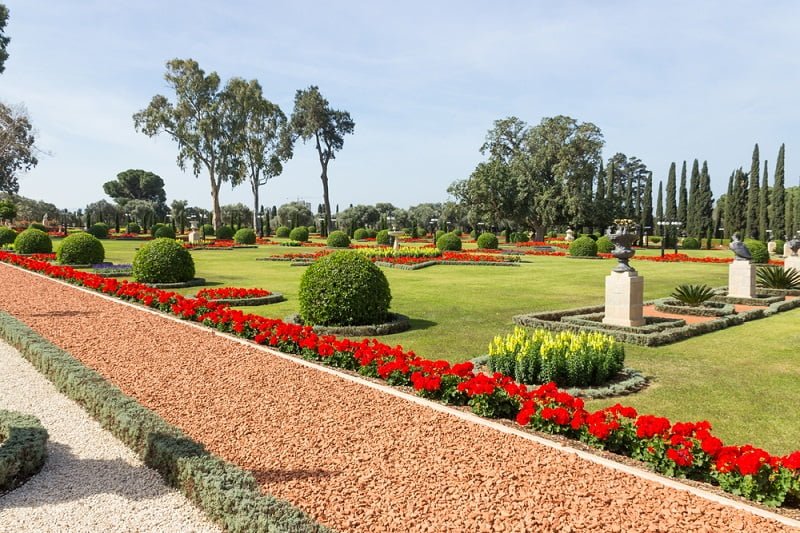If you know a bit about landscaping designs, then you must have heard of hardscape and softscape. Briefly, these two elements are the opposite of each other, but they can still barely exist individually. A landscape is complete only if it contains both hardscape and softscape. However, before including them in your design, make sure you know the differences between them and how to use them.
How Should a Landscape Look?
If you want a perfect balance in your garden or backyard, the ideal thing to do is to combine both hardscape and softscape. Choosing only one of these elements might affect the appearance of your garden.
For instance, focusing only on hardscape would make your yard look a little too industrial and artificial, driving all the warmth away. However, choosing only softscape materials is, again, a bad idea. In this case, it would look like you don’t tend your garden enough, and your entire yard will be surrounded by a feeling of wilderness.
What is Hardscape?
Hardscape is made of hard materials and represents those elements that stay unchanged in a garden over the years. Therefore, if you choose for a hardscape-based design for your garden or yard, you don’t have to worry about taking care of it. Such designs are incredibly low-maintenance.
However, there is one disadvantage. If you are planning to use a hardscape design, you have a lot to work until it’s done. This would represent a much bigger project, and it takes more time and resources. However, it will be worth the effort when you finish the design.
Hardscape Elements
As the name suggests, this type of design contains hard elements. Some of them can be immovable, but others can easily be moved from one place to another. However, all of them are inanimate. This means they don’t wilt or change over time, which makes it a great design for lazier people.
They can be susceptible to extreme weather but, if you pick good quality materials, they should last for a long period. Although such a design is mainly artificial, you can still use some natural elements. These include mostly stone. However, if you want to go fully artificial, you can build structures using other materials, or add other manufactured landscaping elements.
Hardscape Materials
There are plenty of materials you can use when hardscaping, and here are the most popular ones.
Concrete is probably the most popular material used in hardscape designs. It often makes up surfaces of all kinds, and the great advantage is that it is incredibly low-maintenance. Concrete lasts for a long period and allows you to get creative and make surfaces of all kinds.
Bricks are the next most popular material for hardscaping. Their advantage is the fact that they’re more versatile. Bricks are a mix of sand, lime, and some clay, so you can have them in as many colors as you like. If you want to be modern and unique, you can choose bricks in an unusual color. However, most people stay traditional and go for the classic red bricks.
Those stones you often see in pavements represent flagstone. They can create beautiful alleys or walkways and are kept in place by sand or stone dust. An advantage of flagstone is that you can move it whenever you want to without much effort.
In the end, slate is another popular material used for surfaces and decks. Slate is a metamorphic rock, and it exists in this form in nature.
Hardscape Designs
There are plenty of design ideas you can use for hardscaping. Given the big number of materials perfect for surfaces, you can create all kinds of decks and patios in your garden. These look great if you add some other decorative elements like containers or maybe even a fancy fireplace.
You can add alleys and walkways in the same category. To add a nice touch to them, you can place benches here and there, or even a gazebo at the end of a nice alley. These will give architectural density to your garden, and make it look a lot prettier. If you want to keep things a little simpler, even a terrace can do the work.
For a sophisticated design, the best choice is a water feature. If the garden space allows it, you can create an artificial pond, and maybe even build a nice bridge over it. In case of a smaller garden, you can just install a fountain or an artificial waterfall.
Given the versatility of materials, you can create almost any design you like. You can use concrete and stones to build intricate fences, level your garden with the help of stairs, or separate areas by installing walls between them.
What is Softscape?
Softscape includes everything that is animate and can be part of a landscaping design. Of course, these are the plants and trees you have planted in your garden, but they also include some decorative elements as well. Therefore, softscape includes everything from trees, greens, flowers, shrubs, as well as any vegetal ground cover.
The disadvantage of softscape is that its elements don’t last. Most trees and some of the plants might be perennial, but others either need replanting or they wilt during the colder season and get back in bloom in spring. However, if you want to be creative, you can come up with a new softscape design every season.
Softscape Elements and Designs
Of course, the main elements of softscape are plants. You can choose a flower garden that stays in bloom during the warm season and decorates your space with bright patches of color and beautiful scents. In all gardens, trees are usually present, and they create a beautiful green background for the entire design.
For a softscape garden, you’ll need a ground cover. If you don’t have enough small plants, you can plant some shrubs, or even bring some that already grow in containers. You can create a beautiful contrast between taller trees and pretty shrubs.
If these ideas are not appealing enough, you can opt for grass and mulch as ground cover. These elements allow you to be pretty creative and even make some patterns on the ground. If you don’t like mulch, ivy or pine straws can successfully replace it.
Hardscape and Softscape – Differences
For a successful garden design, hardscape and softscape can’t go one without the other. However, it’s important to know the differences between them. This way, you will know how to combine them or opt for the one you want to be predominant.
- Hardscape represents the hard elements in a landscape, while softscape comprises the soft elements. Sometimes, hardscape can be movable, while softscape is immovable. However, you can easily switch these characteristics.
- Hardscape contains inanimate objects, while softscape contains exclusively animate elements.
- Hardscape is strictly solid, and it doesn’t change as time passes. On the other hand, softscape changes every season, as they grow, wilt, or adapt to the weather conditions.
- Most hardscape elements are artificial, while most softscape elements are natural. However, you can easily include natural elements like stone in a hardscape design. Although it’s not so typically used, artificial grasses or plants can be a part of a softscape design.
How to Combine Hardscape and Softscape
Hardscape and softscape go hand in hand, meaning that a garden design would look incomplete without one of them. Before choosing the landscaping ideas for your yard, make sure you pay attention to both hardscape and softscape elements.
If you want a balanced garden that looks neither too barren and cold nor too weedy, you can combine the two design elements. If it’s too hard to tend for a yard covered in grass, you can make a concrete patio or some pretty alleyways made of stone. To avoid an artificial look, you can either plant or place flower containers around.
For a dramatic effect, you can cover your walls, fences, or terrace with vines. This idea is great for big surfaces made of concrete, as they make the space more friendly and warm. Therefore, you don’t have to worry if you don’t have enough soil to plant flowers or trees. Pot plants will do just fine.
You can get as creative as you like when combining hardscape and softscape. Stone decorations go well with plants but, if you have other ideas that you think will look good, feel free to improvise. As long as you feel comfortable in your own garden, you can choose whatever design you find suitable.
Conclusion
Hardscape and softscape are two opposites that cannot go without each other. Together, they offer a feeling of unity and order and can create a beautiful landscape. However, it’s important for them to be in a perfect balance. Choosing too much of one or the other might make the design look too cold or too wild, turning a beautiful garden into a chaotic space.
Therefore, make sure you combine hardscape and softscape cleverly and get the garden of your dreams.












